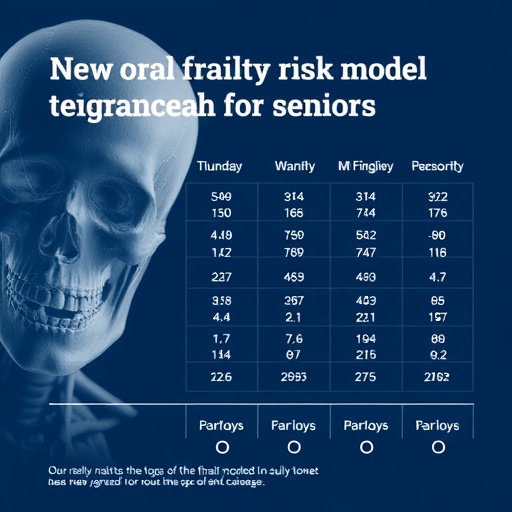In an increasingly aging global population, the emergence of health concerns related to oral frailty has gained heightened attention among researchers and healthcare professionals. Oral frailty, characterized by difficulties in chewing, swallowing, and poor oral health, has significant implications for the overall health and quality of life of older adults. A new study published in BMC Geriatrics offers critical insights into the development and validation of a risk prediction model aimed at identifying individuals at high risk for oral frailty. This model has the potential to revolutionize preventative healthcare strategies and enhance patient outcomes for community-dwelling elderly populations.
The authors of the study, including researchers Lv, Yu, and Xue, embarked on a mission to construct a reliable and scientifically robust prediction tool. Their approach focused on identifying key indicators associated with oral frailty in older adults who live within community settings, as opposed to institutionalized environments, where health management varies widely. By analyzing various health dimensions—such as nutrition, mobility, and dental health—the researchers aimed to create a holistic model that encapsulates the multifaceted nature of oral frailty.
The foundational basis of the model lies in extensive data collection and analysis, reflecting an impressive rigor in the research methodology. The researchers gathered cross-sectional data on older adults, considering diverse demographic backgrounds, health statuses, and living circumstances. This comprehensive dataset was essential in understanding the complexities surrounding oral frailty and ensuring that the model would be applicable to a broad spectrum of individuals.
Building on this foundational data, the researchers employed advanced statistical methodologies to construct the prediction model. Techniques such as logistic regression analysis were utilized to ascertain which variables held the most predictive power for oral frailty. The authors meticulously assessed the relationships between oral health indicators and other health-related variables, revealing crucial insights that could guide future healthcare interventions.
Moreover, the validation phase of the model was equally impressive. The research team conducted a series of rigorous tests designed to evaluate the model’s accuracy and reliability. By employing an independent cohort for validation, they ensured that the prediction tool could perform effectively across different populations. This phase of the study illustrates a commitment to scientific integrity, affirming that the findings are robust and applicable in real-world settings.
The implications of this study are profound, as oral health often serves as a gateway to broader health challenges in older adults. Poor oral health can lead to malnutrition, social isolation, and a declining quality of life. By intervening early, as this prediction model allows, caregivers and healthcare providers can develop more targeted strategies to mitigate these risks. This proactive approach aligns well with global health initiatives that aim to improve the quality of life for the aging population.
As communities recognize the significance of oral health care, the research emphasizes the importance of integrating oral health assessments into routine health evaluations for older adults. This model offers a structured framework for identifying individuals at risk, enabling timely referrals for dental care and nutrition support services. In turn, such interventions can empower older adults to maintain their independence and overall well-being.
Furthermore, the study underscores the critical need for healthcare systems to prioritize oral health as a fundamental component of elderly care. Policymakers should take note of these findings and consider investing in community health initiatives that promote oral health literacy among older populations. Educating seniors on the significance of dental hygiene and nutrition can potentially lead to improved health outcomes and decreased healthcare costs in the long run.
The researchers conclude that their work not only advances the study of oral frailty but also sets a precedent for future explorations in geriatric health. Their model can serve as a template for other researchers seeking to address complex health issues faced by the elderly. By establishing a reliable framework for risk assessment, the study paves the way for a deeper understanding of the interconnections between oral health and overall health in older adults.
As the study gains traction within the scientific community, it has the potential to inform practice guidelines and reshape how health care systems engage with aging populations. Given the substantial societal shifts towards an older demographic, investing in preventive measures such as this prediction model will be crucial. Establishing effective oral health interventions based on predictive analytics can significantly enhance the resilience of community-dwelling older adults.
In conclusion, the research conducted by Lv and colleagues marks a pivotal moment in recognizing and addressing oral frailty among older adults. Their innovative approach not only sheds light on a critical health issue but also offers a pragmatic solution that aligns with contemporary healthcare practices. As we continue to navigate the complexities of aging, embracing research-based strategies will be essential to ensure that our elderly population receives the best care possible.
By capitalizing on the findings of this study, health care providers can shift from reactive to proactive care, ensuring that older adults lead healthier and more fulfilling lives. The development of a risk prediction model for oral frailty is a testament to the advancements in geriatric healthcare and the commitment of researchers to improve the lives of our aging population.
Subject of Research: Oral Frailty Risk Prediction Model for Community-Dwelling Older Adults
Article Title: Construction and validation of an oral frailty risk prediction model for community-dwelling older adults.
Article References:
Lv, K., Yu, P., Xue, Y. et al. Construction and validation of an oral frailty risk prediction model for community-dwelling older adults.
BMC Geriatr 25, 808 (2025). https://doi.org/10.1186/s12877-025-06393-8
Image Credits: AI Generated
DOI: 10.1186/s12877-025-06393-8
Keywords: Oral Frailty, Aging Population, Risk Prediction Model, Geriatrics, Community Health




